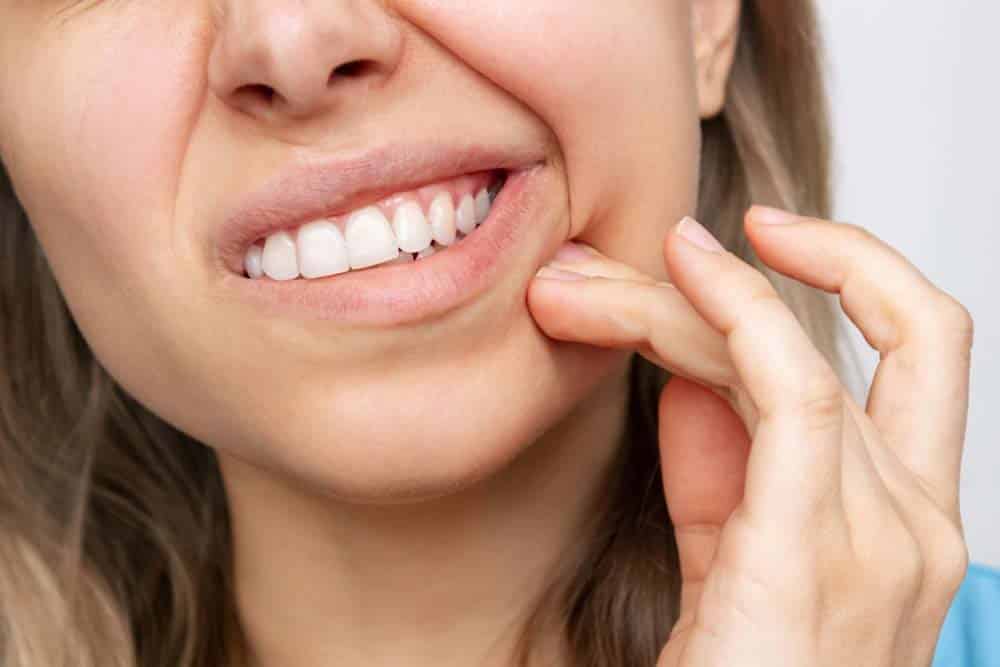
Having a whiter smile is a goal for many people, but sensitive teeth can make teeth whitening a challenge. If you are one of the millions of people with sensitive teeth, you may be wondering if it’s possible to have a bright smile without causing pain or discomfort.
The reasons of tooth sensitivity, the operation of the teeth whitening method, and the hazards related with bleaching sensitive teeth will be discussed in this post.
Understanding the Causes of Tooth Sensitivity
Dentin hypersensitivity (tooth sensitivity) is a common dental issue that affects millions of people. As a result, the tooth’s harder dentin layer becomes visible beneath the enamel that has worn away over time. This layer of dentin has small tubules that go to the nerves within the tooth, which makes them more sensitive to the effects of temperature changes, sugar, acidity, and sweetness.
Several factors contribute to tooth sensitivity, including:
Tooth pain can be caused by cavities or tooth decay, which wears down the enamel and exposes the dentin layer below. This makes the nerve ends in the teeth more visible, which means that hot, cold, sweet, or acidic foods and drinks can hurt them more.
Gum disease or receding gums can contribute to tooth sensitivity by causing the gums to pull away from the teeth, exposing the roots. This exposure can lead to sensitivity, as the roots do not have enamel to protect them like the rest of the teeth. This makes them more susceptible to pain and discomfort when exposed to certain stimuli.
Inner dentin can be exposed by chipped or broken teeth. Dentin is not protected by enamel, so this exposure might increase tooth sensitivity. Chipping or cracking teeth can make eating hot, cold, sweet, or acidic foods uncomfortable.
Grinding or clenching teeth (bruxism) wears down enamel, exposing sensitive dentin. Grinding and clenching can enhance tooth sensitivity and discomfort while eating some foods and drinks.
Acidic foods and beverages can erode the protective enamel layer, exposing the sensitive dentin underneath. This exposure can increase tooth sensitivity, making hot, cold, sweet, or acidic meals and drinks more painful. These products should be limited to protect dental enamel and prevent sensitivity.
Overuse of abrasive toothpaste or brushing too hard can also wear down the protective enamel on teeth, exposing the sensitive dentin layer. This can lead to increased tooth sensitivity and discomfort when consuming hot, cold, sweet, or acidic foods and drinks. It is important to use a soft-bristled brush and gentle brushing technique to prevent damage to the enamel.
Understanding the underlying cause of your tooth sensitivity will help determine the best course of action for teeth whitening.
How Teeth Whitening Works
A popular cosmetic dental procedure, teeth whitening aims to eliminate stains and discoloration from the surface of the tooth. It works by using active ingredients such as hydrogen peroxide or carbamide peroxide to break down the stains on the tooth enamel, revealing a whiter, brighter smile.
The Risks of Whitening Sensitive Teeth
While there are treatments that can give you whiter teeth, it’s essential to consider the risks associated with whitening sensitive teeth. The active ingredients in whitening products, such as hydrogen peroxide or carbamide peroxide, can cause or exacerbate tooth sensitivity. This is because the peroxide can penetrate the tooth enamel and reach the dentin layer, potentially causing discomfort or pain.
Additionally, overuse of teeth whiteners or improper application can lead to tooth dehydration, which may temporarily increase sensitivity. In some cases, the increased sensitivity may be temporary, but for individuals who are already uncomfortable, it can lead to long-lasting tooth sensitivity.
What Are Whitening Options for Sensitive Teeth?
For individuals with sensitive teeth, several whitening options are available. These options typically involve lower concentrations of peroxide or gentler formulas that minimize tooth sensitivity while still providing noticeable results.
- Over-the-counter products for sensitive teeth: Some whitening toothpaste, mouthwashes, and strips are specifically formulated for sensitive teeth. For example, Sensodyne True White toothpaste and Crest 3D Whitestrips Dental Whitening Kit Gentle Routine use lower concentrations of peroxide and are designed to minimize sensitivity.
- At-home whitening kits for sensitive teeth: Some at-home teeth whitening kits offer custom trays and a choice between sensitive or regular formula, such as Smile Brilliant Professional Teeth Whitening Kit. These kits allow for a more controlled and comfortable whitening experience.
- In-office professional whitening for sensitive teeth: Dentists can adjust the bleach concentration and the application time during in-office whitening treatments to accommodate sensitive teeth. They may also use desensitizing agents before or after the treatment to minimize discomfort.
Professional whitening treatments are the safest choice for people with tooth sensitivity because over-the-counter teeth whiteners may contain harsh chemicals that can make symptoms worse. Additionally, while some over-the-counter products may provide noticeable results, professional treatments typically offer more dramatic and long-lasting results.

How to Prepare Your Sensitive Teeth for Whitening Treatment
To minimize discomfort and potential risks associated with teeth whitening for sensitive teeth, prepare your teeth for the treatment. Here are some steps you can take before starting a whitening treatment:
- Schedule a cleaning: Schedule a dental check-up and cleaning to remove any plaque or tartar that will interfere with the treatment.
- Use a toothpaste for sensitive teeth: Start using a toothpaste like Sensodyne or Colgate Sensitive at least two weeks before your whitening treatment. These toothpastes contain ingredients like potassium nitrate that help reduce tooth sensitivity.
- Address any underlying dental issues: Dental health issues can exacerbate sensitivity, and bleaching agents can potentially cause discomfort if applied to compromised teeth or gums. Treating underlying issues ensures that your teeth are in good condition for the bleaching process.
- Stop chewing on ice: Chewing on ice is a habit that puts excessive pressure on the teeth and this can lead to enamel erosion and increase tooth sensitivity over time.
Post-Whitening Care for Sensitive Teeth
After your teeth whitening treatment, it’s essential to take proper care of your sensitive teeth to minimize discomfort and maintain the results. Here are some post-whitening care tips for sensitive teeth:
- Use a whitening toothpaste: When choosing a whitening toothpaste, be careful to avoid abrasive ingredients and opt for a brand that will whiten while protecting your enamel.
- Avoid hot and cold foods and beverages: Temporarily avoid consuming extremely hot or cold foods and drinks, as they can cause discomfort to sensitive teeth.
- Steer clear of acidic foods and beverages: Limit your consumption of acidic foods and drinks, as they can weaken tooth enamel and increase sensitivity.
- Use a soft or extra soft toothbrush: Continue to practice proper oral hygiene by brushing twice a day with a soft-bristled toothbrush, flossing daily, and using a fluoride mouthwash.
- Use a straw: When drinking staining beverages, use a straw to minimize contact with your teeth and reduce the risk of staining.
Tips for Maintaining the Whiteness of Sensitive Teeth
To preserve the whiteness of your sensitive teeth after treatment, follow these tips:
- Avoid beverages and staining foods: Reduce your intake of items such as coffee, tea, red wine, dark-colored foods, and dark sodas that can cause staining. If you do consume them, rinse your mouth with water afterward to minimize staining.
- Do not use tobacco products: Both smoking cigarettes and using smokeless tobacco products can lead to dental discoloration and staining. Tobacco contains tar and nicotine, which can adhere to the enamel surface of the teeth, causing yellowish or brownish stains. Some patients wonder if vaping is a safer option, but vaping can also harm your teeth and gums, so it’s best to avoid it entirely.
- Schedule regular dental cleanings: Visit your dentist for regular check-ups and professional cleanings to remove surface stains and maintain your overall oral health.
- At-home maintenance: Wear your custom whitening trays as recommended by your dentist.
- Consider touch-up treatments: Depending on your cosmetic treatment and the level of sensitivity, you may need touch-up treatments every six months to a year to maintain your desired level of whiteness.
Consulting with a Dentist for Whitening Sensitive Teeth
Before starting any cosmetic dentistry treatment such as teeth whitening, consult with a dentist who can assess your individual needs and recommend the most appropriate option for your sensitive teeth.
Schedule a consultation with John Paul Gallardo, DDS, founder of Gallardo Periodontics & Dental Implants in Miami, FL. Dr. Gallardo is a highly experienced periodontist and cosmetic dentist who offers KöR and Phillips ZOOM!, which are state-of-the-art whitening systems. He can help you determine the cause of your sensitivity and address any underlying oral health issues that may contribute to it. Don’t let sensitive teeth hold you back from having the beautiful smile you always wanted.